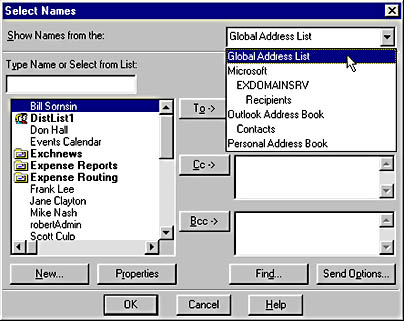Working with Data: The NameSpace Object
You learned in the preceding section that by using the NameSpace object, you can access the AddressLists collection. The AddressLists collection contains all of the different places where the addresses of users can reside. Through this collection, you can access individual AddressList objects, which are the actual address books. The methods and properties of the AddressLists collection that you should be interested in are the Count property and the Item method. As you would expect, the Count property returns the number of AddressList objects in the collection, and the Item method allows you to access individual AddressList objects. Most times the AddressList object that your application will access will be either the user's personal address book or the Exchange Server Global Address List. Figure C-5 shows you a list of available AddressLists in the Outlook client.

Figure C-5 The Outlook Address Book viewer showing a list of available address books, or AddressList objects.
The following example shows you how to scroll through the AddressList objects by using the Count property and Item method, and how to retrieve specific AddressList objects by using their names:
Sub CommandButton1_Click On Error Resume Next set oNS = Application.GetNameSpace("MAPI") set oALs = oNS.AddressLists for i = 1 to oALs.Count msgbox oALs.Item(i).Name next 'The Exchange Server GAL can be available both online and offline set oGAL = oALs("Global Address List") if oGAL is Nothing then set oGAL = oALs("Global Address List (Offline)") end if msgbox "Accessing the " & oGAL.Name & " by name." set oPAB = oALs("Personal Address Book") msgbox "Accessing the " & oPAB.Name & " by name." End Sub |
AddressList Object
The AddressList object is accessed through the AddressLists collection. This object contains the AddressEntries property for attaining the actual directory entries in the AddressList. The following example shows you to how count the number of AddressEntries by using the AddressList object to access those AddressEntries:
Sub CommandButton1_Click set oNS = Application.GetNameSpace("MAPI") set oALs = oNS.AddressLists set oALPAB = oALs("Personal Address Book") intCount = oALPAB.AddressEntries.Count msgbox "There are " & intCount & " entries in the " & oALPAB.Name End Sub |
EAN: 2147483647
Pages: 184